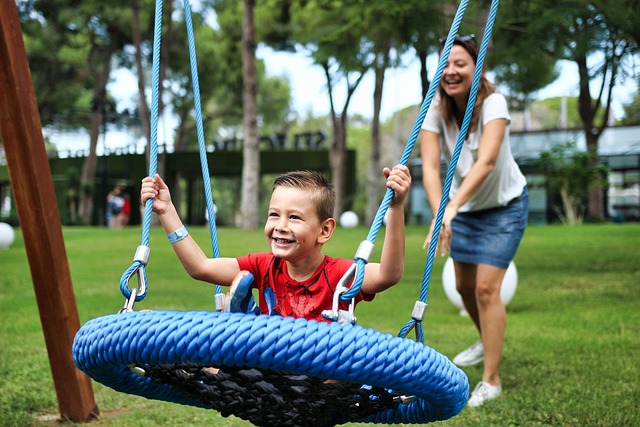You Have Childcare Responsibilities
Between school, after-school activities and sports, kids can have schedules as busy as their parents. Just because you have carpool duty or need to make sure your tween gets to practice on time doesn’t mean you have to neglect your own fitness goals.
In fact, exercise can be a great activity for the whole family. Making time for a workout doesn’t just benefit your health, it also sets a good example for your kids.
How to Accommodate Kids & Workouts
Exercising with kids requires planning, but it’s not impossible. If you look at your community, you’ll likely find some good resources.
- Utilize childcare: Join a healthy or gym with a daycare center.
- Find the right time: Use an online video or fitness app when the kids are napping or you’re waiting for dinner to cook.
- Include them: If they’re old enough, invite your kids to be part of your routine. Show them how to lift small weights, have them count your repetitions, or take them along on your daily walk.
- Choose family-friendly activities: If you’d enjoy coaching or mentoring, see if there are opportunities to be more involved with your child’s sports team.
- Rethink exercise: Challenging kids to a running race or playing an animated game of tag can burn calories too.

You’re Too Stressed
Being stressed can make everything more difficult to face—workouts included.3 At the same time, waiting until you feel like exercising can backfire. Motivation is something you have to work at every day.
Start by setting reasonable goals and remind yourself of them every day. Each time you reach a goal, whether it’s completing your workouts for the week or feeling more energized, reward yourself.
Go for a massage, put together a new workout playlist, buy new running shoes, or spend a quiet night at home curled up with a good book. Also talk with others about their goals and how they stay motivated. If you aren’t part of a gym or class, join some message boards or social media groups.
Additionally, focus on how you feel rather than the numbers on the scale or what you see in the mirror. If you aren’t seeing changes in your body as soon as you’d hoped, it can be discouraging. But there are other benefits to working out, such as better balance and more energy, that you might be overlooking.
Keep it simple. Sometimes the thought of changing into workout clothes can seem like climbing a mountain. Choose activities that require very little preparation, like walking, gardening, cleaning the house, or stretching.
Make the transition easier. If you tend to stay more sedentary when you’re stressed, going from sitting to something active can seem like a big jump. Give yourself five or 10 minutes to get your body moving a bit before exercise. Try light cleaning, some stretching, or simply walking around the house a bit.
Give yourself extra time to warm up. If you’re doing a high-intensity activity(like running or aerobics), give yourself more warm-up time than usual. If you usually start out jogging, start with a slow walk. Allow your body all the time it needs to get warm and allow your heart rate to climb gradually.
Give yourself extra time to cool down. It’s always a good idea to end your workout feeling good. Give yourself at least 10 minutes to wind down and then spend a few minutes stretching.
Take baby steps. Thinking about doing 30 minutes of activity may feel overwhelming if you’re busy. Decide that you’ll just do a few minutes of something. Chances are it’ll feel so good that you’ll want to keep going.
You’re Tired and Sore
Exercise can be uncomfortable, especially in the beginning when you’re trying to find your stride. Once your body adapts, it starts to get easier. Still, even those who have been exercising for a while experience some soreness after a hard workout.
If your workout is truly painful, you may need to try something else to avoid injury. If the soreness is just the result of your body getting used to moving more, try starting slower.

Start with a few days of moderate cardio like walking and basic strength workouts to build endurance and strength. You should be able to carry on a conversation if you’re working at a moderate intensity. Then, you can ease into strength training.
With weight training, an effort is needed to build lean body tissue. When you’re just starting out, any weight you lift is going to require effort. In the early days, focus more on maintaining good form. Then increase your weight once you’ve mastered the exercise.
If you have been working out for a while and find that you are more sore or exhausted than usual, take it as a sign your body needs an extra rest day to repair and recover. It is important to listen to your body and allow for rest when it’s needed. Pushing yourself beyond your limits could result in injury.
You Can’t Commit
When you only think about exercise in the long term (“I have to do this forever!”), it can be overwhelming. Keep in mind that you don’t have to change everything in your life all at once, and not all the changes you make have to happen overnight. If you’re having trouble sticking to your workout routine try to switch up your perspective.
First, start with small, attainable goals. It’s easier to stick with a workout when your goals start small. Try challenging yourself to walk an extra 10 minutes each day or get up early for a short yoga workout.
Also, ask yourself if a fitness routine is truly important to you or if you just want it to be. Making exercise a priority takes commitment, and commitment takes motivation. Figure out what your goals are, but keep them realistic.
And finally, don’t focus strictly on weight management. If your only goal is weight loss, it can be hard to stick to a routine if you don’t see results right away. While you don’t want to lose sight of your long-term goals, try giving some of your attention and focus to the other benefits of exercise.
You Don’t Have Time
When you’re looking at your to-do list, it might feel like you just don’t have time to exercise. But exercise doesn’t need to take a lot of time to be effective. And, if you look more closely at how you spend your time, you might realize you’ve got more of it to carve out than you thought.

How to Prioritize Workouts
- Put your workout on your schedule. Keep a calendar of your workouts so you can track your progress and stay motivated.
- Break up your workouts. Just because you can’t find a 30-minute slot of time during your day for a workout doesn’t mean you can’t work out at all. Try breaking your activity up into 10- or 15-minute segments. Research has shown that split workouts are just as effective as continuous workouts.
- Add more movement to your day. Get up a few minutes early and take a fast walk, use part of your lunch break for a stretch, or take the dog out for a romp after work. Even small changes, like parking at the far side of the lot or taking the stairs when possible, add up over time.
- Focus on the positives of exercise. Aside from feeling better, improving your fitness level, and reducing the risk of certain illnesses, exercising regularly will give you more energy and help you sleep better. After all, exercise generates energy, and the more energy you have, the more you’ll get done each day.
A Word From Verywell
A regular exercise program can deliver many physical and mental health benefits, but finding the motivation and time for a workout isn’t always easy. Find the right strategy and routine that works for you and take time establishing an exercise calendar that’s ideal for your schedule and lifestyle. Above all, be patient with the workouts and yourself as you figure out your fitness journey.
